Now it was the time to take the fast train TGV to Les Sables d´Olonne, heart of France´s professional sailing sport, like Vendeé Globe, to take over a brand new Excess 11 catamaran. With our clients we had an agreement that for the first couple of miles I will be accompanying the crew on their maiden voyage to act as counsellor, sailing trainer and share my experience in offshore sailing. Well, that was a kind of honor since I wouldn´t consider myself an “experienced offshore sailor” but, anyways, of course I agreed and was very happy that my capabilities seemed to spark confidence in our clients.
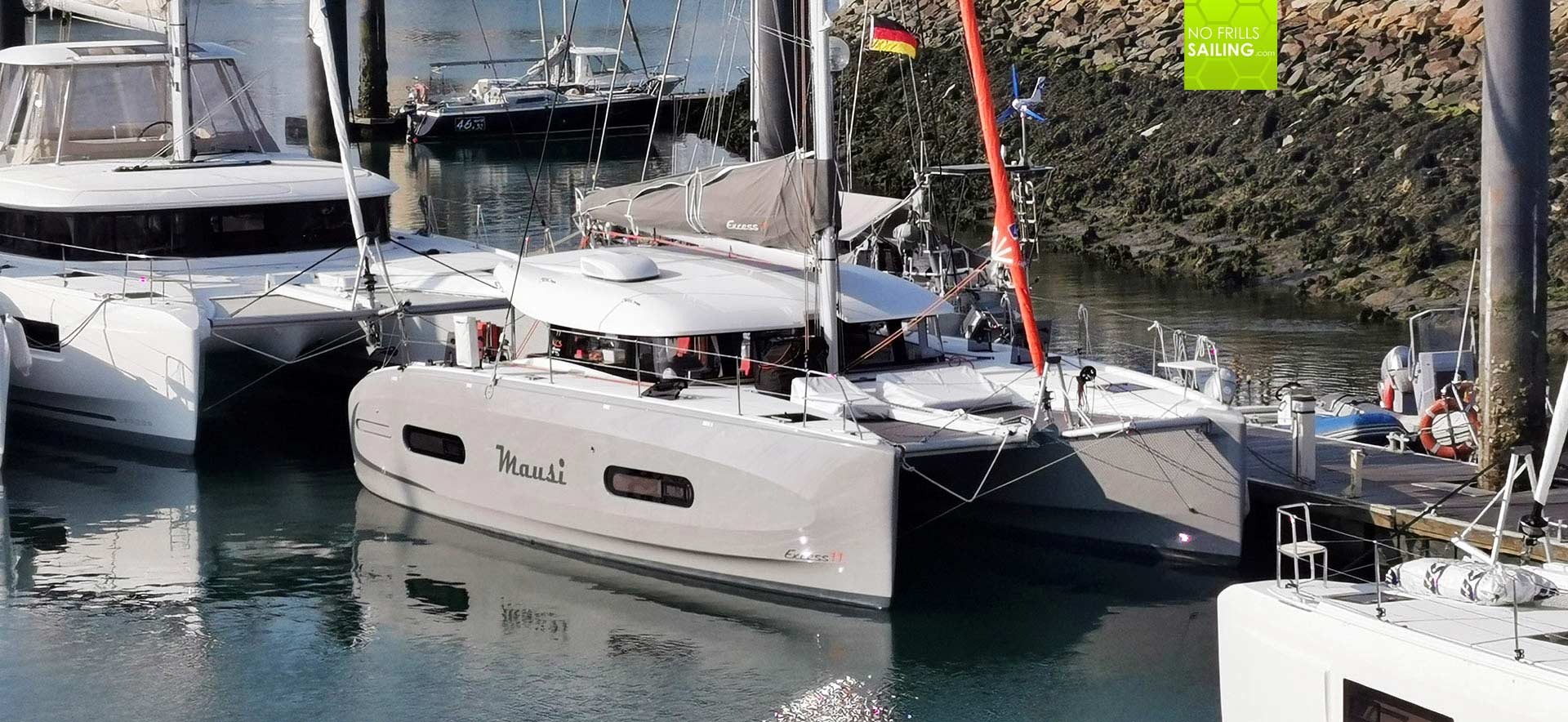
As I arrived late that night the catamaran had already been handed over by one of my colleagues and been readily stowed with provisions, fuel and fresh water. Ready to casting off. Next day, upon inspection of the cat, the owner himself called to cancel his participation due to a personal health issue (no, this time not Covid), thus leaving his two sons, 21 and 24 years of age, alone with me on the catamaran. That promised to make this even more exciting: Although the boys were experienced boat-people, they had only been owners of power boats and never ever sailed a single mile on a boat, let alone on a catamaran. Let´s start then …
Forging a crew.
We checked for wind (of which there was virtually none) and for the tides in Les Sables to cast off at 1 p.m. the following day. I refrained from acting as skipper because I thought that wouldn´t be the best idea: The two boys would have to go on sailing that catamaran for another 2.500 miles (!) alone without me and thus I reckoned my prime task aboard would be to train the guys how to handle the boat technically and to boost their confidence in each other as a double handed crew, able to tackle this huge task. I understood my mission to be a “teacher” and counsellor.

The casting off-manoeuvre was executed by the older brother, whom I considered being the skipper, with excellence: His capabilities in driving power boats absolutely helped steering the catamaran. Which is not done by screw and rudders but by the screws alone. He performed a flawless procedure and soon the cat was on its way out of the estuary and onto the open sea. Both were excited (as was I) and on the quays tourists, fishermen and strolling couples waved to our brand new beautiful boat, wishing us luck and fair winds. Of which I didn´t talked tot he guys all-too openly, I must confess.
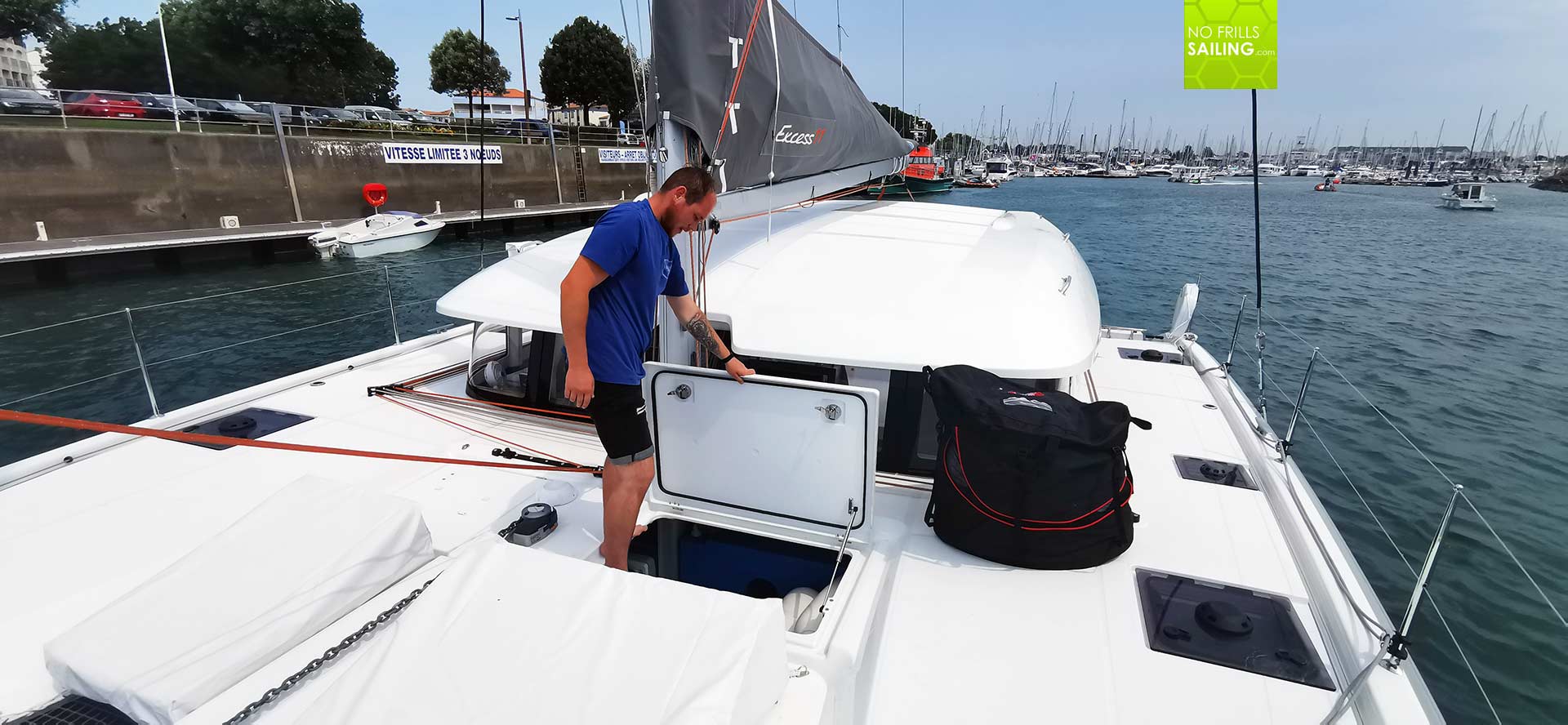
We cleaned the boat from all lines, fenders, shore power cable and stuff not needed whilst sailing and stowed away securely all loose items. At the mast, I showed the younger brother how to make sure that the mainsail will go up flawlessly from the lazy bag and back down in the cockpit we untied all the halyards and sheet, the reefing lines and other ropes to a sailing-ready state. I started to explain where the lines go and which purpose each one had whilst we steered free from Les Sables, rounding a restricted area and out to the open sea.
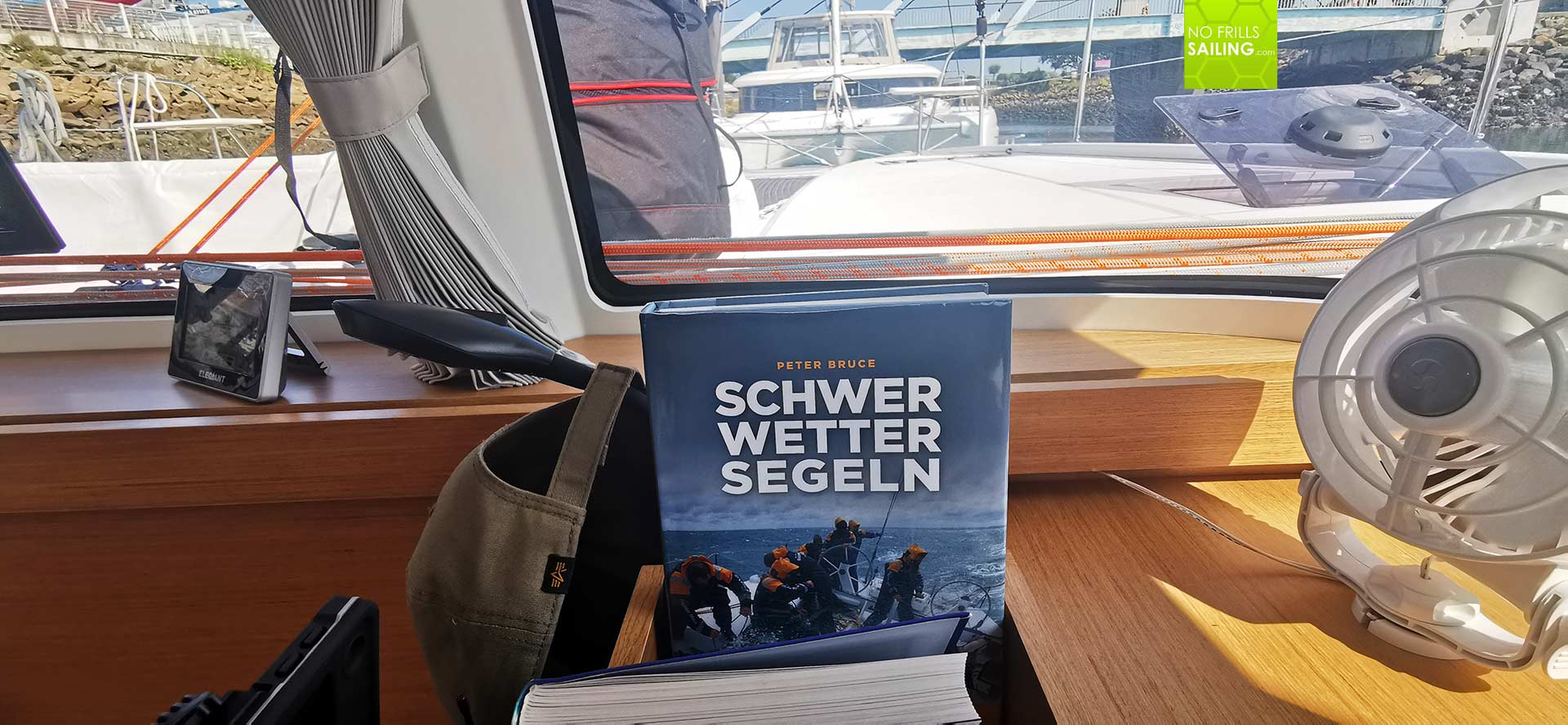
Well, I smiled a bit as I saw a book in the shelf on position number 1 in the saloon: “Storm sailing” it said and like a harbinger of things to come it loomed there, glowing in the midday sun that was shining like hell, creating a luring sense of lushness and vacation-like weather. I already knew that this wouldn´t be the case for too long, but kept this for me until the time would be right to tell the crew. For now my focus was on basic sailing training for the guys.
Smooth sailing – easy handling: Excess 11 Catamaran
As for the Excess 11 sailing catamaran, handling and operating the lines is a no-brainer. The boat has been developed to be sailed by minimum crew – say: One single person – and thus everything was reduced to a minimum in complexity but a maximum of efficiency. I showed the boys that the starboard winch was the primary work-station for the helmsman: Mainsail halyard, the twoo reefing lines and the mainsail and job jib sheets are operated all on this single place. As it is common sense in sailing that the starboard side is the “prime” side of the boat, it made sense. As we had steered free, I announced „Ready to hoist sails!” The older brother, knowing somehow how to do it, wanted to go dead into the wind, which I told him not to do. Instead, I shortly explained the masthead fly and asked him to steer the catamaran to an upwind course. “Some 45 degreed to the wind”, I added.
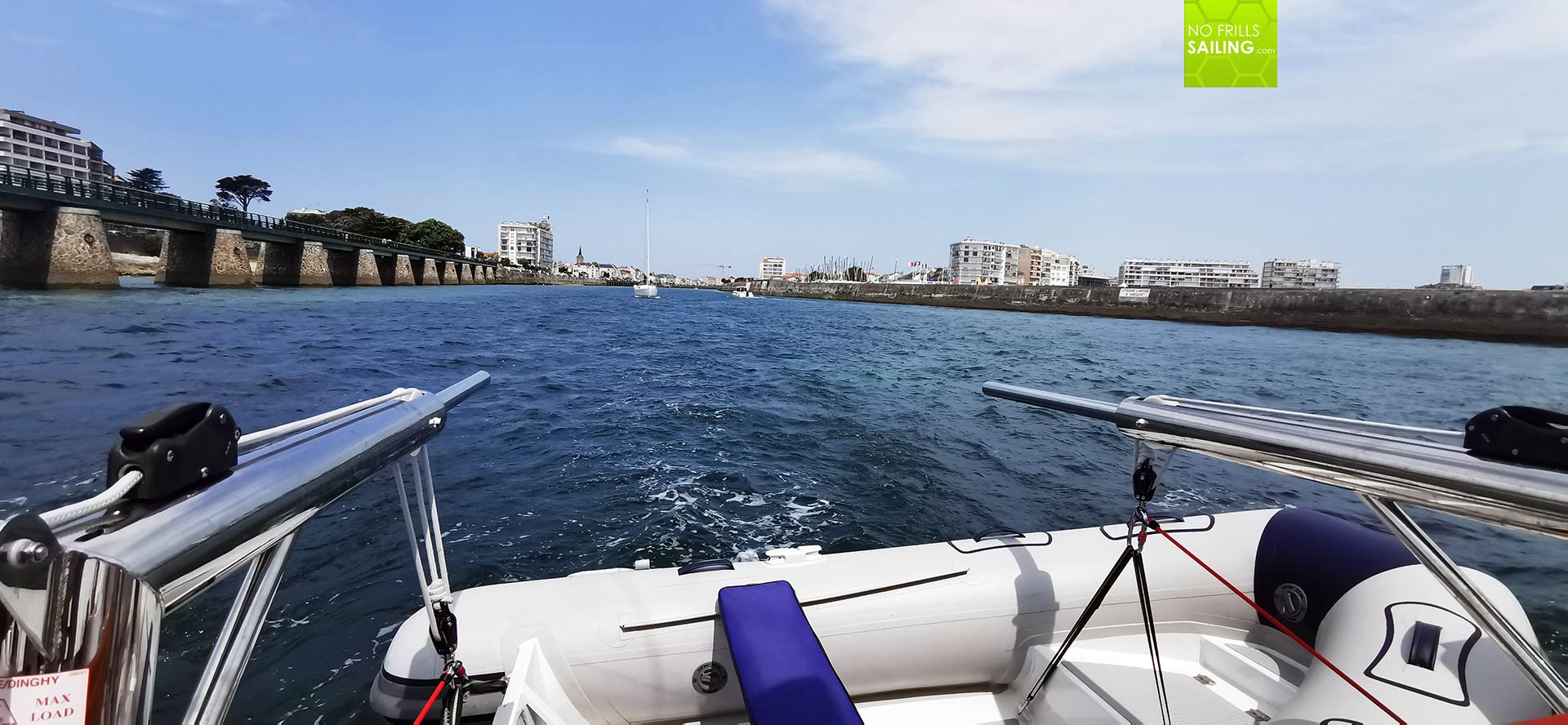
With a short pull on the jib sheet the sail unfurled and the electric winch quickly tightened the rope. “No kill the engines”, I asked the brother. After loosing the unnerving sound of the Diesels, the catamaran sailed under wind power, and it was a true relief. Both smiled and looked at me like “see, we have made a first step here!” I explained that – from my personal point of view – it was much easier and more relaxed not to power up to dead windward to hoist mainsail, plunging head-on into the waves, creating turmoil and stirrup. Instead, sailing close hauled upwind with jib first would make things much smoother and elegant.
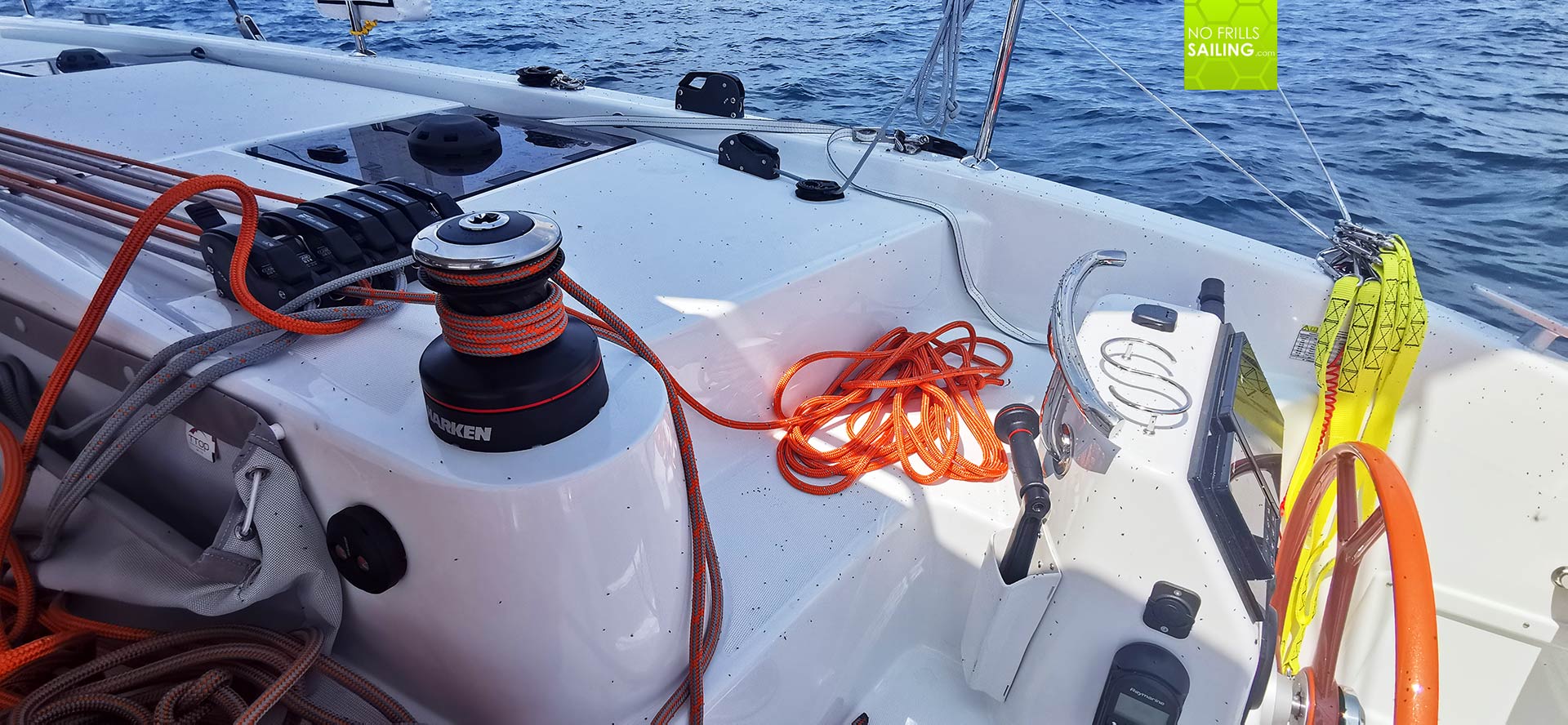
We loosened the mainsheets and let the boom being flown outward by the wind. Then I put the mainsail halyard to the winch and seconds later the big mainsail was up. Sheeting in the ropes again, the boom was put amidship and the canvas filled up with wind – the catamaran powered up. Both were smiling brightly: “It´s that easy?”, they asked. I nodded: Yes, it was. No stress, no wild manoeuvres and no rocking by dead-on taken waves. Just upwind sailing under jib and easy hoisting of the mainsail. I resumed: “For later, even when reefing, try to do it without engines by just sailing upwind, let fly to boom and operate the mainsail this way. Your guests will be thankful for not being thrown around by waves.”
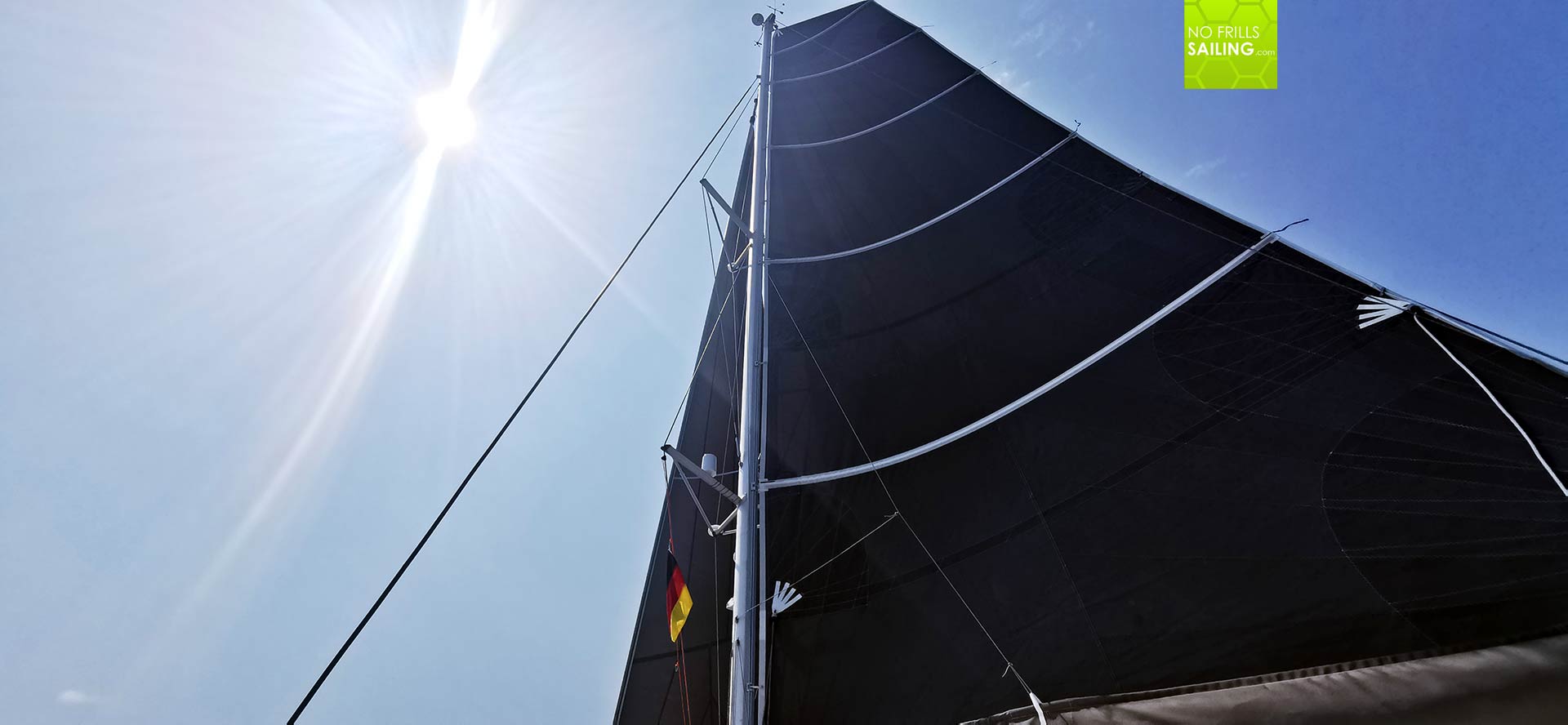
I concluded this first „session” in basic sailing training by explaining the tell-tales of the jib and the mainsail, demonstrating by easing and tightening the sheets how to trim the canvas. Of course I knew that this was way too much in way too less time, but both boys seemed clever and confident. By repeating and trying out by themselves they saw on the speedo which actions led to which speeds: Easing too much the cat would lose a knot or two, luffs would start to flutter and momentum getting lost.
A slow start?
After that first kind of exciting two or three hours of training, things settled a bit and routine started to kick in. We calmed down, everybody looked for his place in the wide open cockpit in the aft and we started to appreciate the moment. As wind was very light at that time, 8 to 10 knots AWS, we sailed on with some 4 knots SOG. I opted for a high upwind course steering nearly due West on 230 degrees – it was time to tell the guys.

„Look, we are not sailing the straightest way crossing the Bay of Biscay because of the weather that is coming in soon.”, I started. “Right now I want us to make as much headway towards West as we can, every single mile counts.” Why? Because right at that time I knew that a stormy low-pressure system was approaching from the open Atlantic Ocean, bringing high wind speed and – much worse – a turmoiled sea state to the Biscay. My idea was to go out as much westerly as I could, knowing we would have bear away to avoid a head-on storm. Bearing away meant going South – as wind prediction showed a south-westerly wind that would have meant a south-easterly course for the catamaran. “I think reaching A Coruna is out of discussion. We will try to reach Gijon but I fear it won´t work, so Santander might do it.” Well, as it turned out, I would be right in this assumption.

Nevertheless, the boys took it with attitude and we enjoyed the last hours of calm sailing. I was astonished of the fact that the Excess catamaran´s pointing abilities were in fact pretty good. AWA-display showed sub-40 degree angres, masthead fly assumed some 40 to 45 degrees. The catamaran thus sailed very, very good, taking into account that common opinion on catamaran sailing abilities state that they were poor. Well, for this Excess I cannot agree: In fact, the performance amazed me!
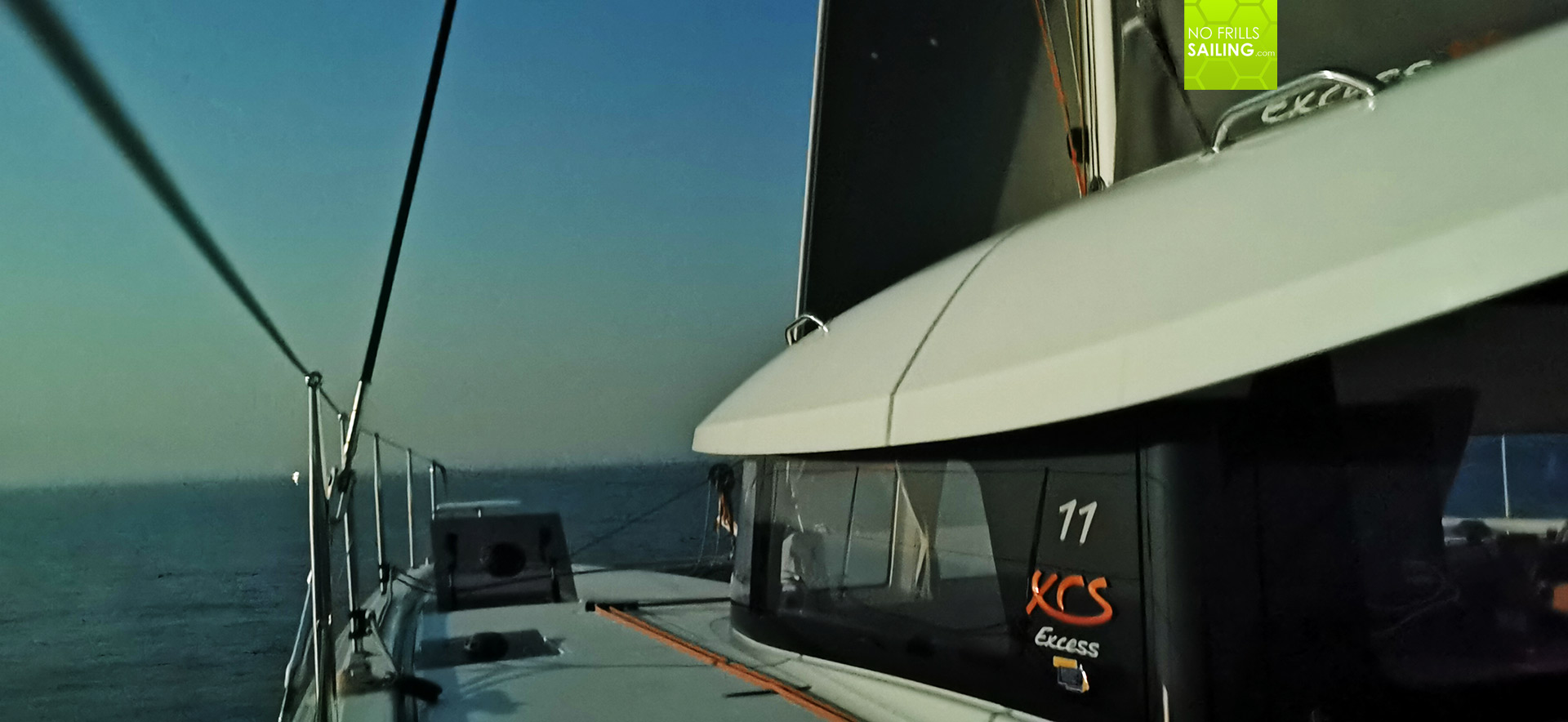
As we sailed into the night I talked with the boys about the watch system. I proposed a system of three watched with three hours for each of us, leaving 6 hours of sleep and 3 hours of duty. Both never had sailed through the night non-stop but agreed. I let the younger brother for the first shift as I assumed sailing into darkness with the last sunshine and the light of the full moon in light winds would be least frightening. I set myself to take the second shift from midnight to 3 a.m. as I assumed that this would be the time of arrival of the heavy winds (with all manouvres and course corrections needed). The elder brother would then be 3 to 6 a.m., when I assumed the boat would be steadily sailing on its new course, fully reefed and the boys would be kind of accustomed to the expected heavier motions in the stirred-up sea state.
Here comes the wind …
It started during the night and wind increased to 23 knots. Going that hard upwind would have been possible much longer but I beared away to 180 degrees course due South to avoid an all-too heavy rocking through the waves which quickly started to build up. Although reefing of the main close hauled is safe till 23 knots as said by the yard, I put in the first reef in the main soon after wind speeds got higher than 20 knots. I had a feeling that maybe this heavy-wind-passage would be very stressful for the boys so I did not wanted to overstress their threshold.
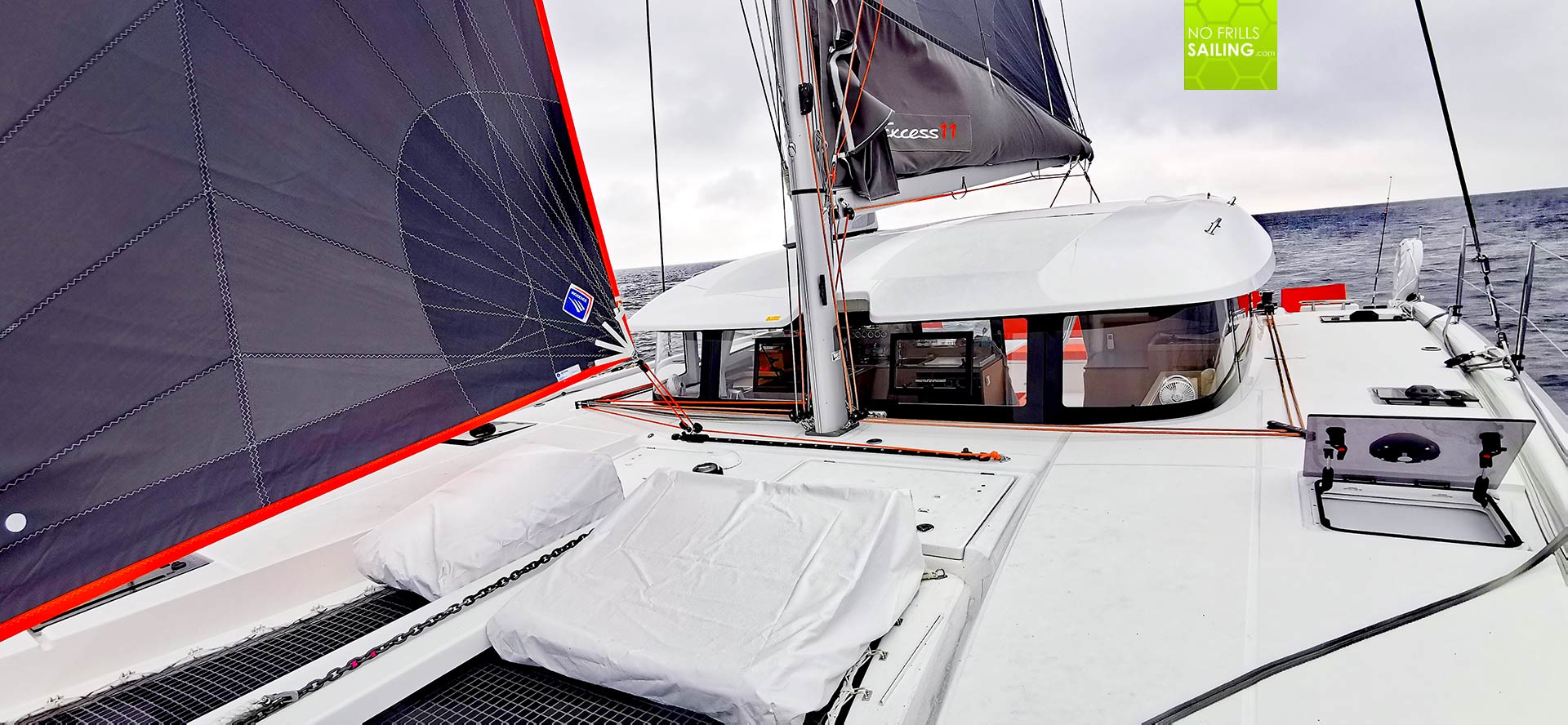
During the following day wind increased slightly to 28 knots an average, hitting peaks of 32 knots in occasional gusts. The catamaran steered an AWA of 50 to 60 degrees and it did most perfect! It was the best angle to take on the waves (which started to break, wild whitecaps all over the place) and connected to it was the idea to have the best compromise between making as much headway as possible but to keep a safe course without adding too much stress for both boat, rigging and her crew. Nevertheless, I was excited oft he performance of the boat, which, honestly, exceeded my expectations and what I have read or heard about catamarans by far.
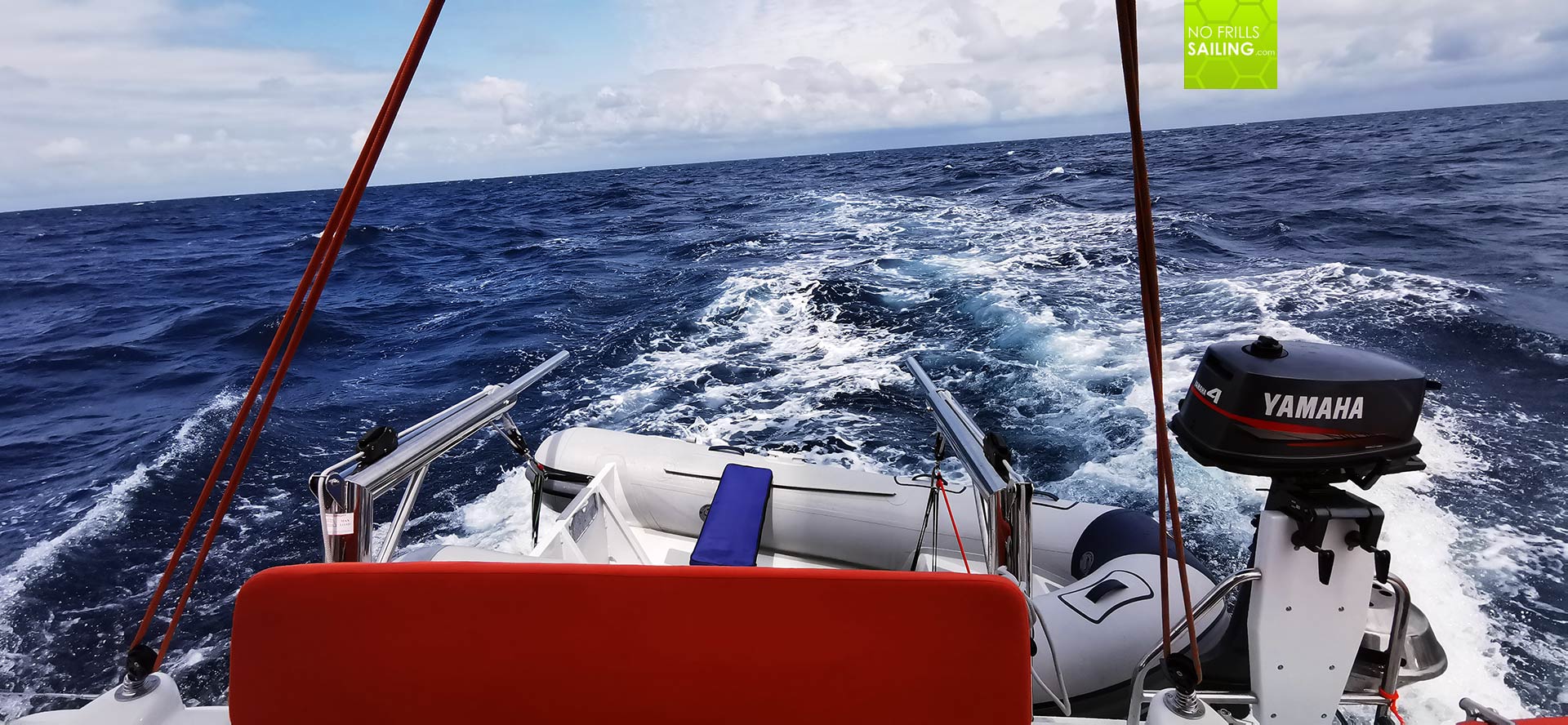
As waves built ever so slightly and wind increased, it was first the older brother of them two who succumbed to sea sickness. After relieving himself over the reeling, I told him to go down immediately and have himself restrained to horizontal position in his bed, which he did. The younger brother had a strange feeling in his stomach too but told me he considered himself fit for taking on his watch-duties. Nevertheless, switching from a 3-shift system to 2 shifts (with a seemingly groggy helmsman) was not a good prospect. From the forecasts I knew that the sea state would be going on being like this for another 20 hours with wind gradually decreasing.
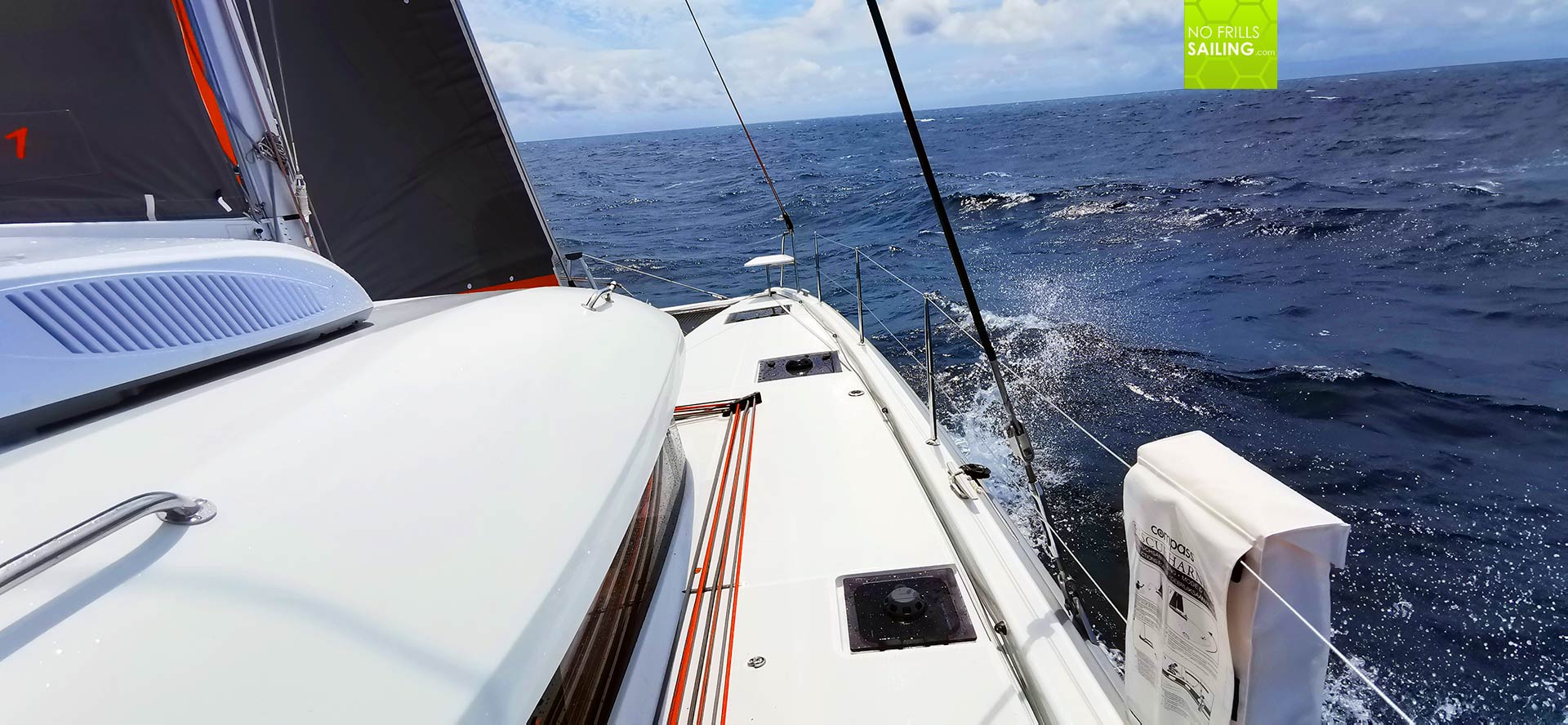
The boat was rocking through the night. I quickly noticed the main differences between a monohull and the cat. Where a monohull is sailing with constant heeling and going in “longer”, maybe smoother motions through the waves, a catamaran won´t heel at all (well, just a tiny bit, but barely noticeable) and the motions of the hull are shorter, rockier and more “abrupt”. That is, of course, because the hull will be hit two times by one wave. Sometimes a wave would go underneath the windward hull without any notice but hit full strengths the inside of the second, leeward, hull. That would often create a loud bang – just noise, no harm.
Heavy weather: Seasick on a Catamaran?
Either way, this heavy weather was too much for my young crew mates. On the second morning the younger brother prepared a simple but hit meal: Pasta with Pesto. I loved it, the other fed it backwards to the fish again with the elder brother disappearing down below. Poor guys face was pale white and I could not do anything more than encouraging him to drink sufficiently and lay down horizontally as much as he could. So, the myth that there is no chance of being seasick on a cat is nonsense. Any boat, no matter how many hulls it may have, must ride the waves and hence is prone to some kind of motion. As for the catamaran: No heeling, shorter movements.
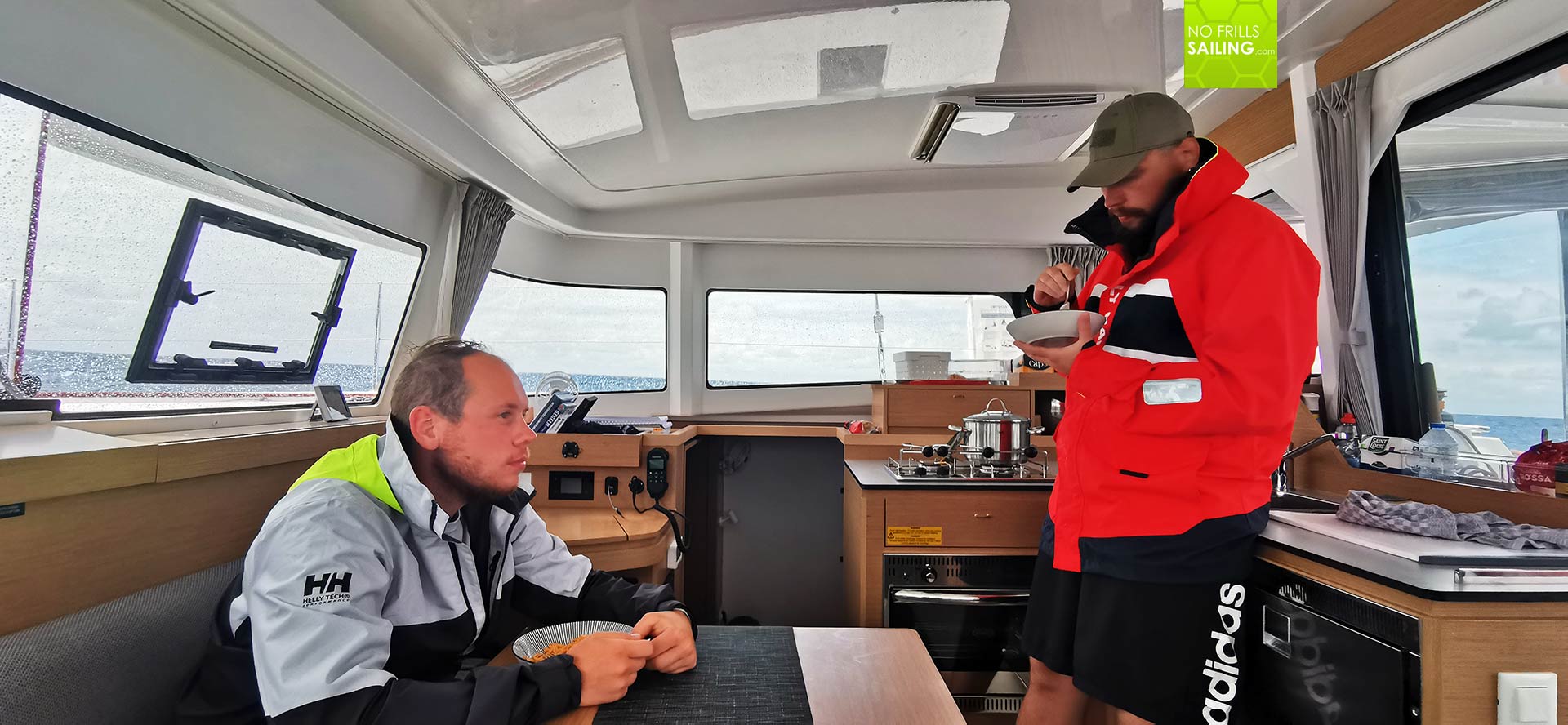
But that, in my opinion, was a good thing. Of course, at the height of the storm when the waves reached 4 to 5 metres, violently breaking and rocking the boat, going from A to B on the catamaran was very shaky and one had to grab a safe handle to not fall. But I´d say the motion was far less than on a monohull, maybe this impression is fostered by the fact that we did not had to cope with additional heeling, like on a mono. I sailed through the night and it became a rush: The boat´s trail was foaming as we regularly hit the +8.5 knots SOG-mark. Best speed during the night has been 8.8 knots SOG in winds of 28 knots with first reef in the main and full jib. Amazing! I did never had the feeling of being unsafe or that the catamaran might be overpowered. Also my – maybe a bit exaggerated – fear of a catamaran “just” being inherently stable and not stable by weight and leverage of a keel, was absolutely unnecessary. It felt as stable as any good boat I was ever aboard.
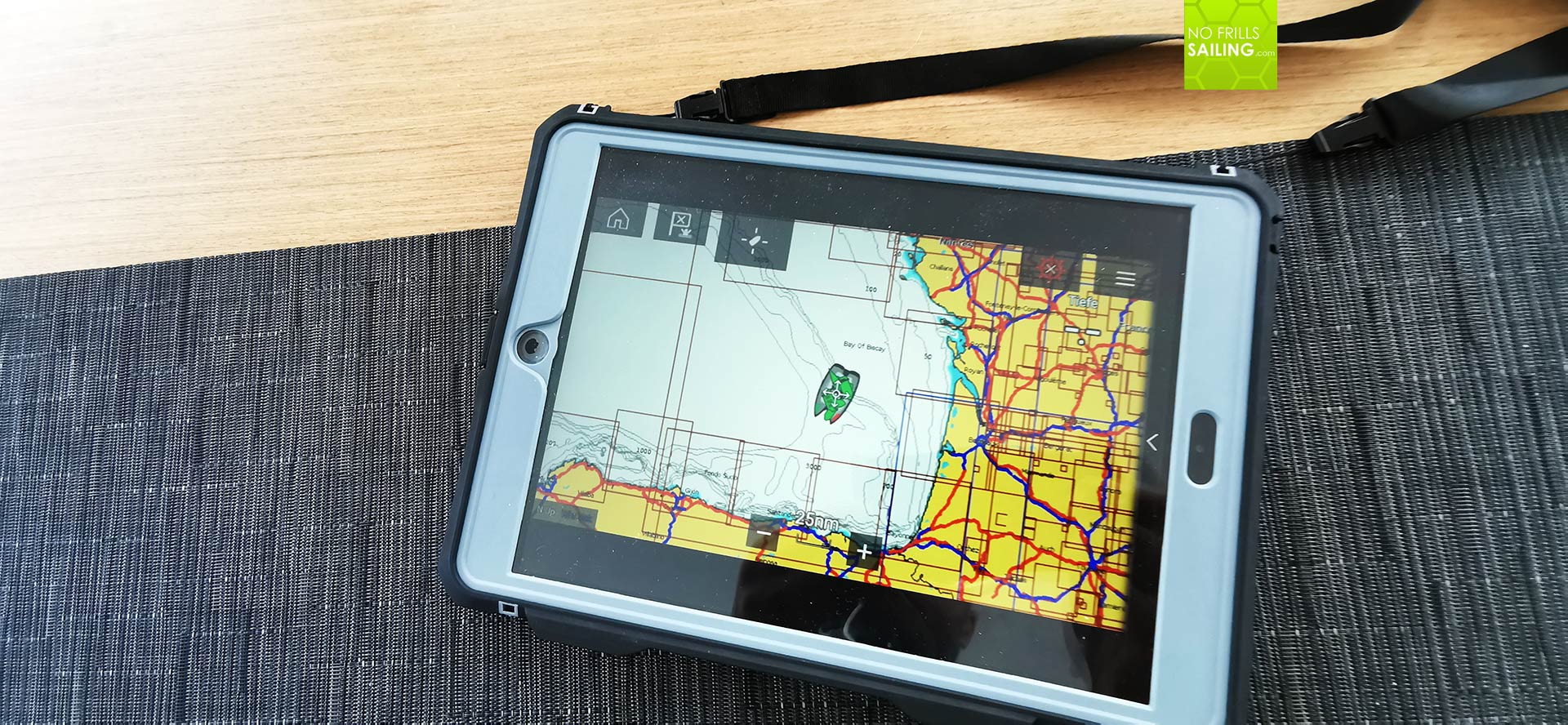
My strategy began to work out just fine: The idea of going West as many miles as we can so that, when force to bear away from the storm, a southerly course would lead us to the westernmost possible Spanish harbor paid out. The catamaran made very fast progress through the water and it ate the miles away like nothing. With an average of over 7.5 knots (remember, still on 50 AWA) it was the best compromise between efficient upwind sailing and mileage. The hours went by and occasionally one of the boys showed up on deck just to disappear again after a few minutes. I hoped for the guys to recover quickly. Slowly the wind speed – as predicted – began to drop gradually and some hours later the wave height came down ever so slightly.
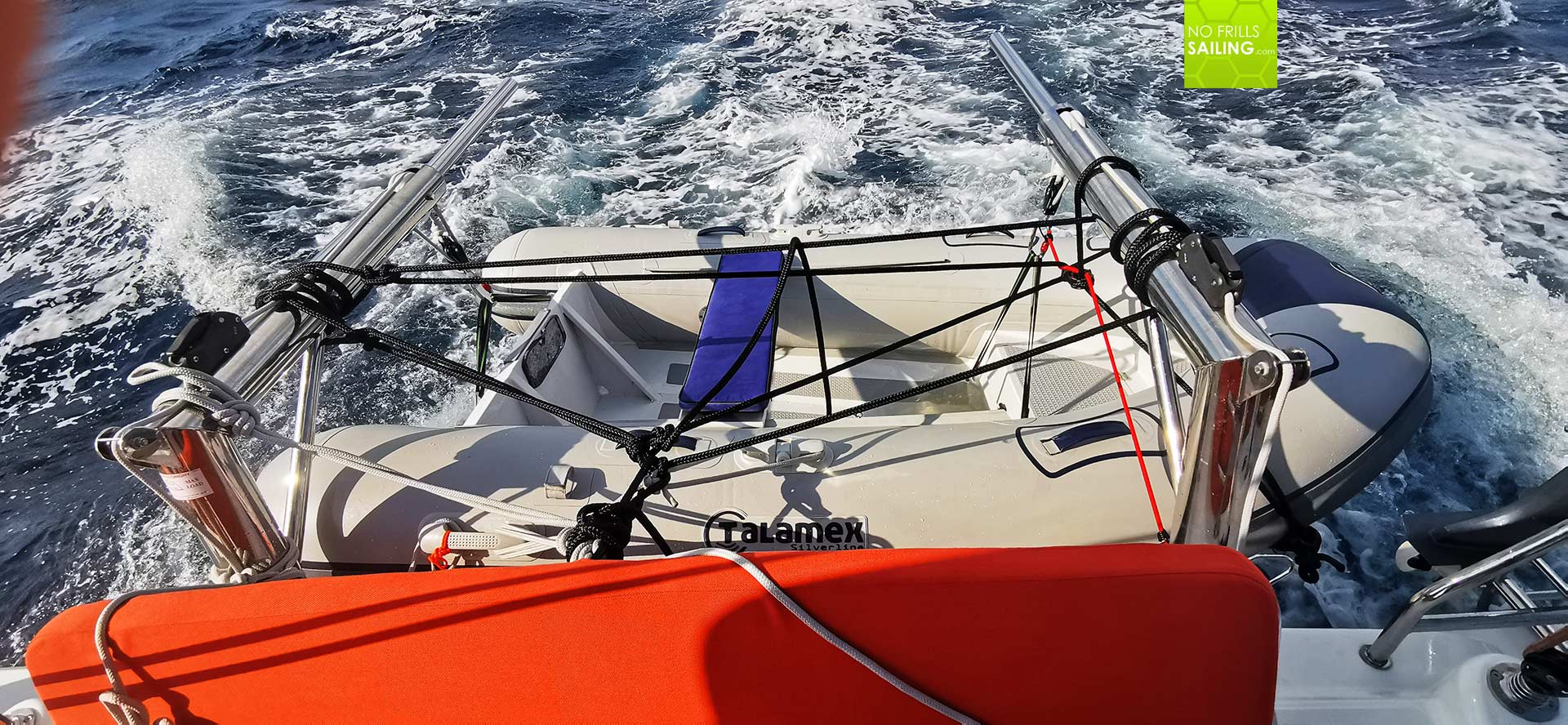
I checked the boat and apart from the ropes securing the dingy on the davits aft, which had been broken already or severely damaged, the boat showed no signs whatsoever of wear and tear. The sails were up and standing proud. I grabbed some lines and secured the dinghy to the davits which was frequently battered by waves crashing it into the hull. Slowly getting used to sailing mainly alone, I figured out a good routine for my watches.
A surprisingly quick and safe passagemaker
That said, most of the time during the night, but also in the chilly morning hours, I sat in the saloon. From there you have got a full 360 degree round sight and can perfectly well look out for other boats (of which more and more fishing boats appeared) and obstacles. Checking instruments, like the log or wind, could be done on the tablet which was connected to the Raymarine-network. I was even able to send steering commands to the autopilot via remote.
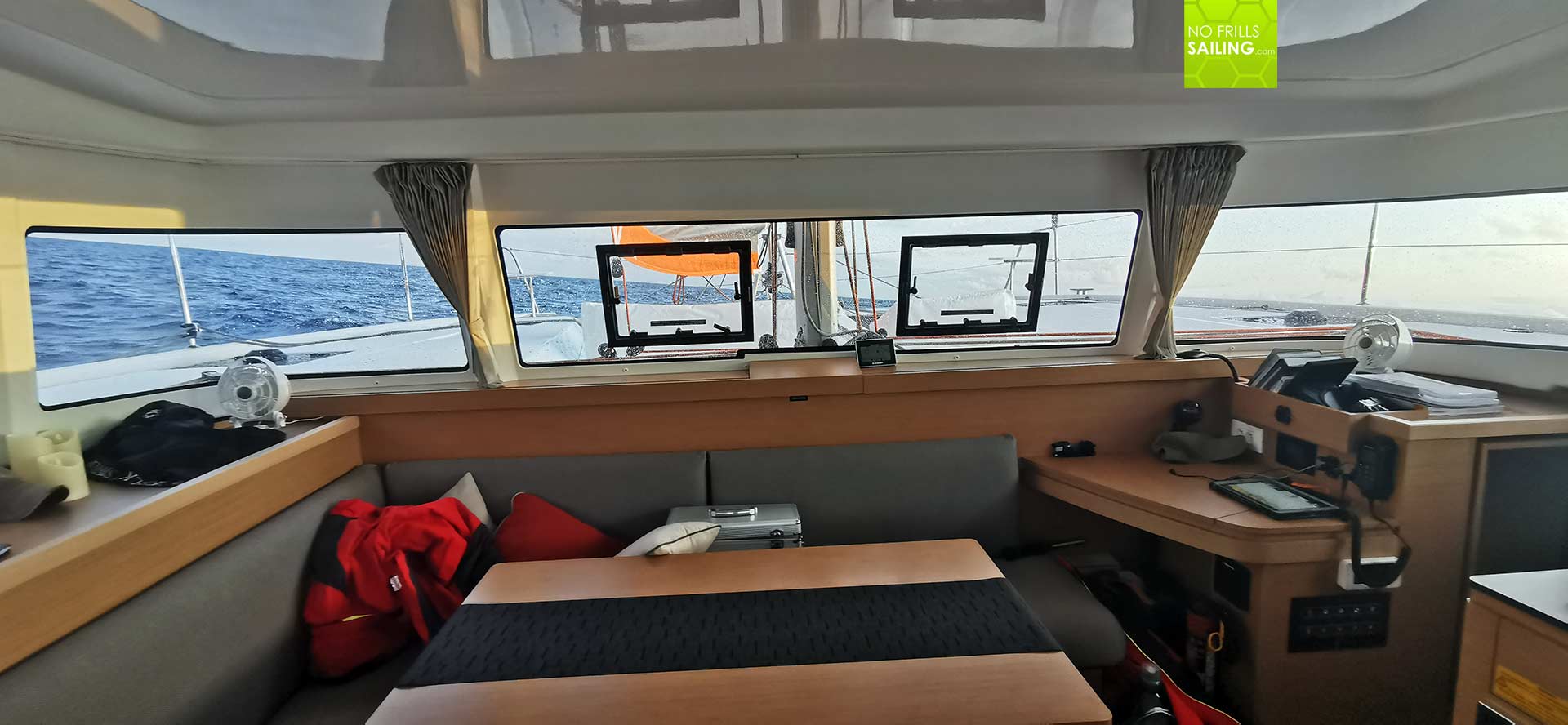
Nevertheless, I occasionally went outside to look up into the mast, check for our position lights or look at the tell tales for adjusting the sails trim. In this, sailing a catamaran on long haul trips is very, very less stressful for the helmsman. The saloon is protected, warm and dry and conveys a perfect sense of security and confidence. Also, the perspective changes. Many state that being up so high above the water may disconnect them from the sea. It may be so for them – for me personally being up high and looking down onto the boiling Ocean was transporting a feeling of being safe. I liked it. Also, being in the saloon for a snack or having a drink, does not send you “down in the basement” but you are still above the water.
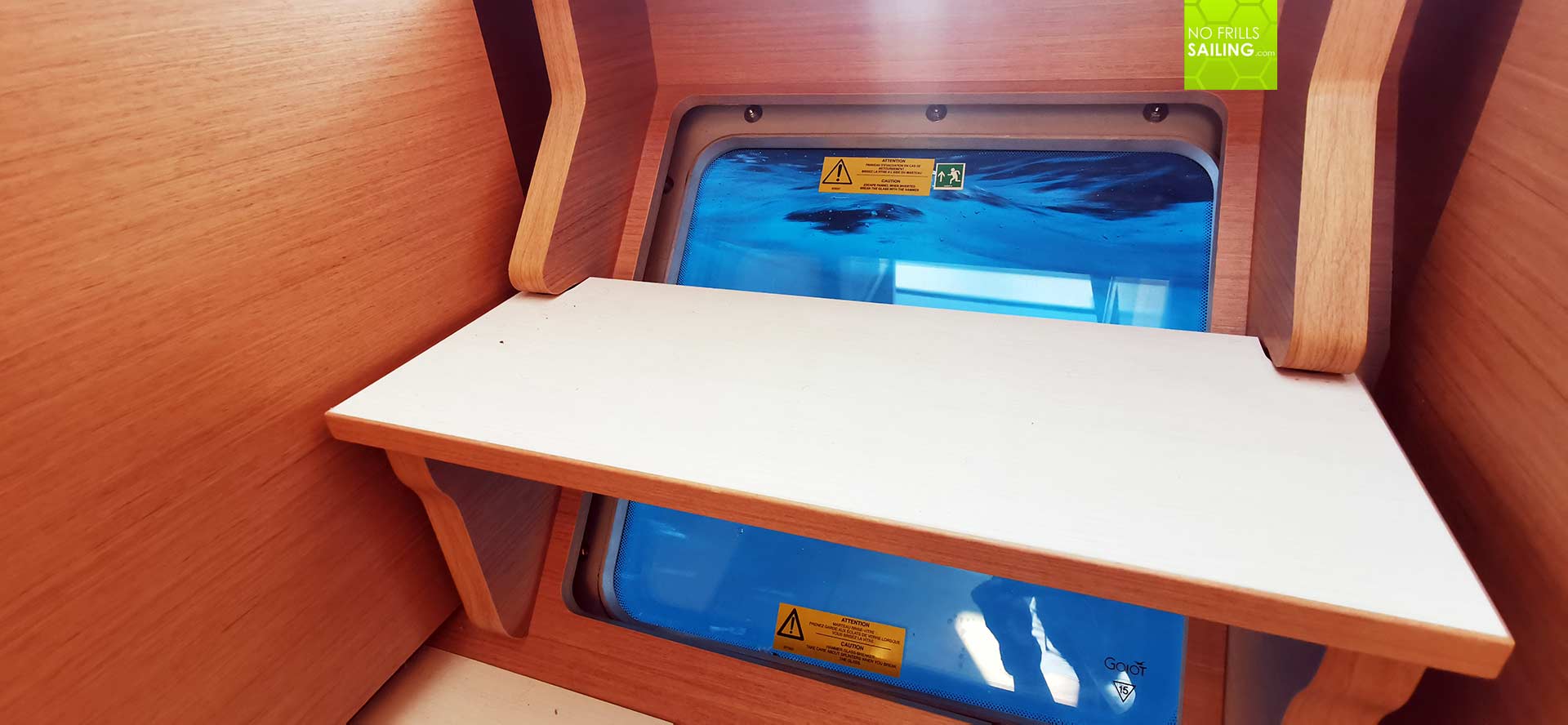
Which also applies a bit to the cabins. I hope you excuse my default of taking some pictures of my cabin (which of course I will make up in the upcoming catamaran-delivery article) – but I can assure you that these big, big, big hull windows of the Excess-cabins offer a fantastic and exciting view outside: It is not a slim arrow slit but a full size panoramic window. Now, laying in your bed, you can have a great view outside and watch the water flow by. This also adds in my opinion to a good feeling, even in the worrisome sea state, because seeing is knowing. Alone the gruesome noise of the water battering the two hulls was at times unbearable, but ear plugs should be in any sailor´s duffel bag.
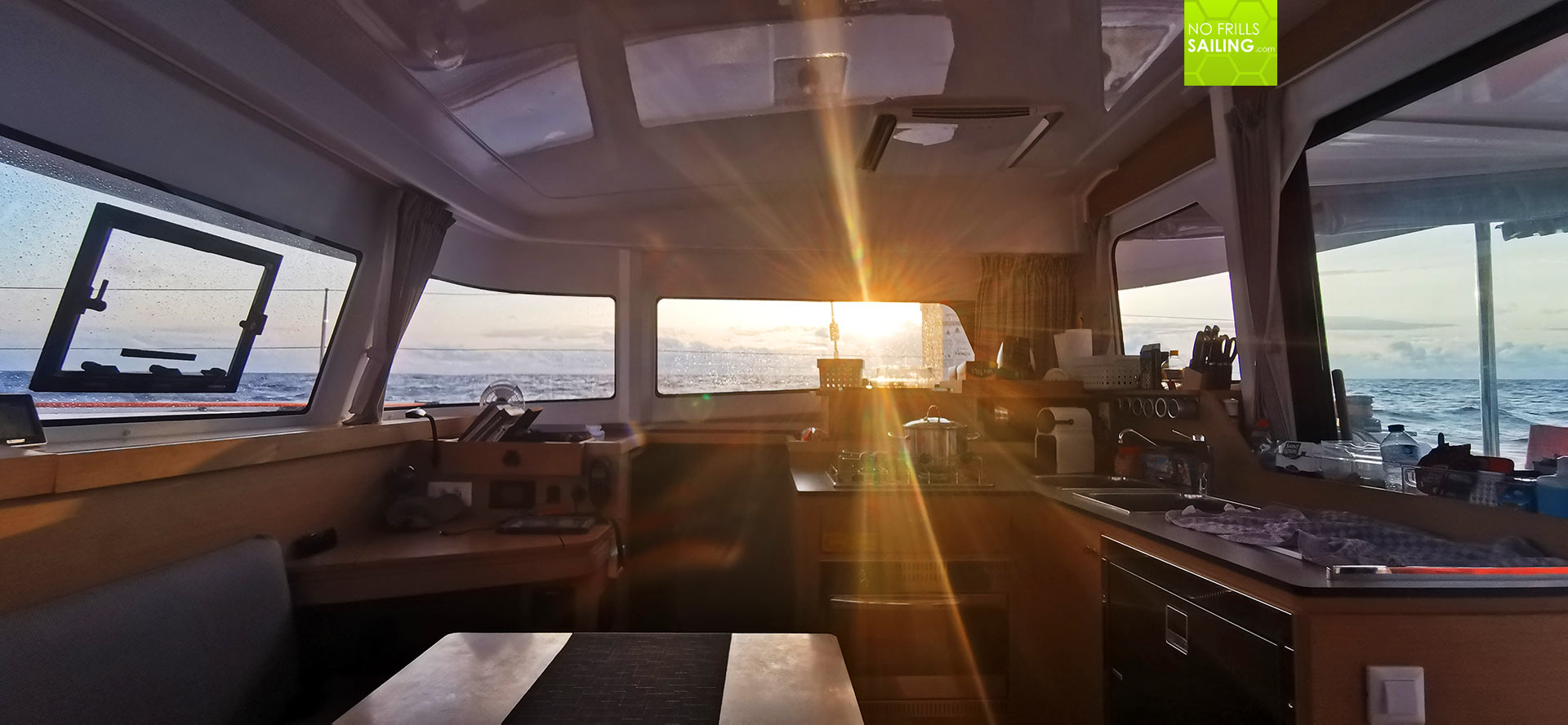
One big disadvantage or downside, nevertheless, I spotted. And I don´t want to hide this fact, maybe encourage the yard to think this over: The stove in the galley of the Ecxess 11 is a non-moving built-in type. So it simply cannot be used when the boat is moving and going about in a sea state with waves. It is just impossible. Pots will slide off, hot boiling contents will splash out. That is a definitive minus. On our whole 48-hour passage from Les Sables d´Olonne to Santander we have only been able to cook a hot meal for one single time! And even then one of the guys had to constantly press the lid of the pot firmly down with his hand, constantly changing a towel that got hot. That must be changed to a gimballed stove quickly, I would say and I hope the yard will – at least as an option – start to offer this.
Eating the miles away: Approaching Spain
So I sat down occasionally and filled up my cup with cold noodles to get at least my stomach stuffed with something. Luckily the Spanish coast was approaching fast and the catamaran did not lose any of its speed. In my personal logbook I noted at 3 p.m. the second day with still 25-28 knots of wind: “Angle to reach Gijon is too steep. Decision to go to Santander.” This was a bit disappointing since I knew that with prevailing Westerlies and still some 250 miles to go to Cape Finisterre the Bay of Biscay is far from being conquered.
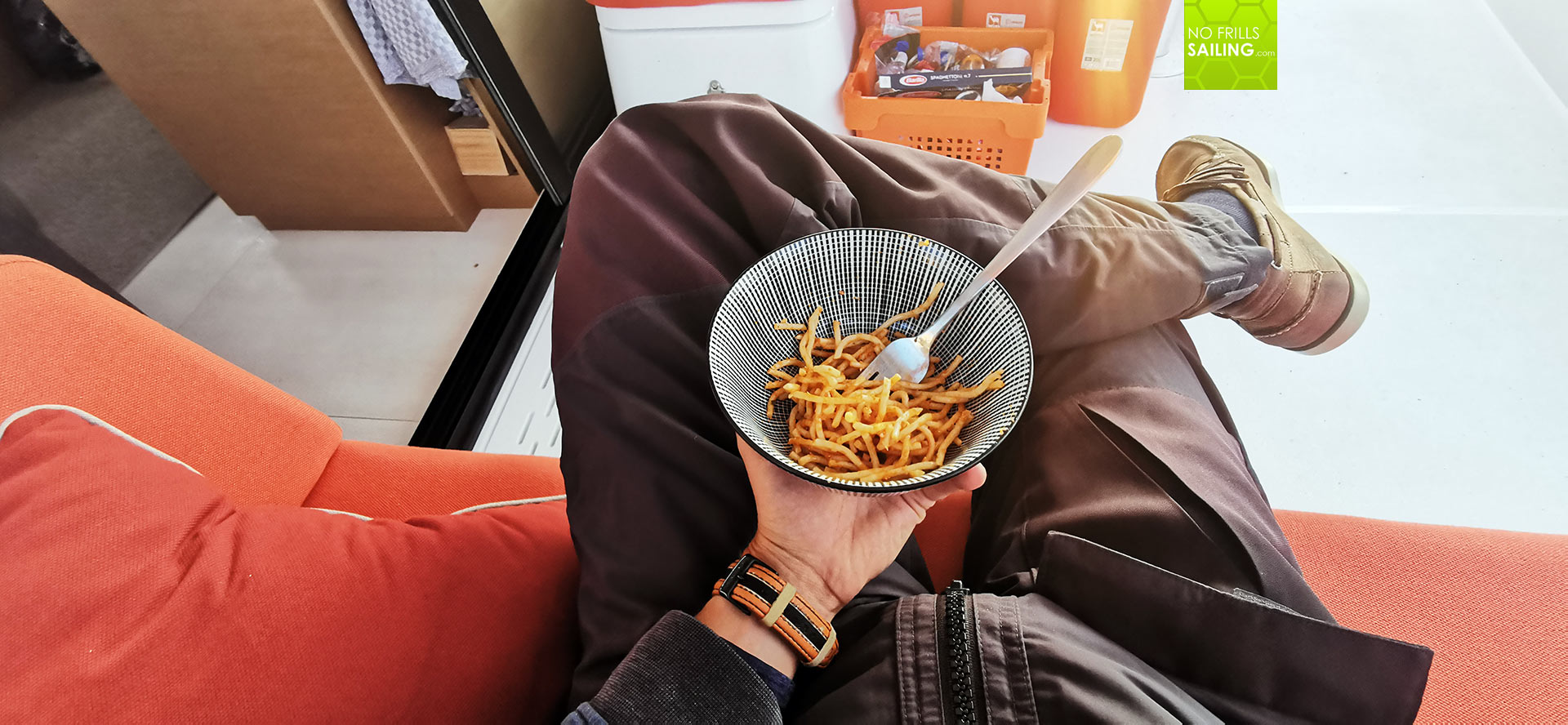
But looking at the situation, going in a brand new boat with two non-sailing guys being hit hard by sea sickness the it was the best decision I could make. As the second night approached and I prepared myself to another single handed sailing night I saw that there were only 60 miles to go left and that may have meant with a speed of 7 knots just under 10 hours still left. My strength was gradually going down, I was yawning every minute and there wasn´t a chance to get a hot coffee nor any hot meals. To brighten things up, the younger brother appeared and that granted me three hours of sleep, which I embraced and utilized instantly.
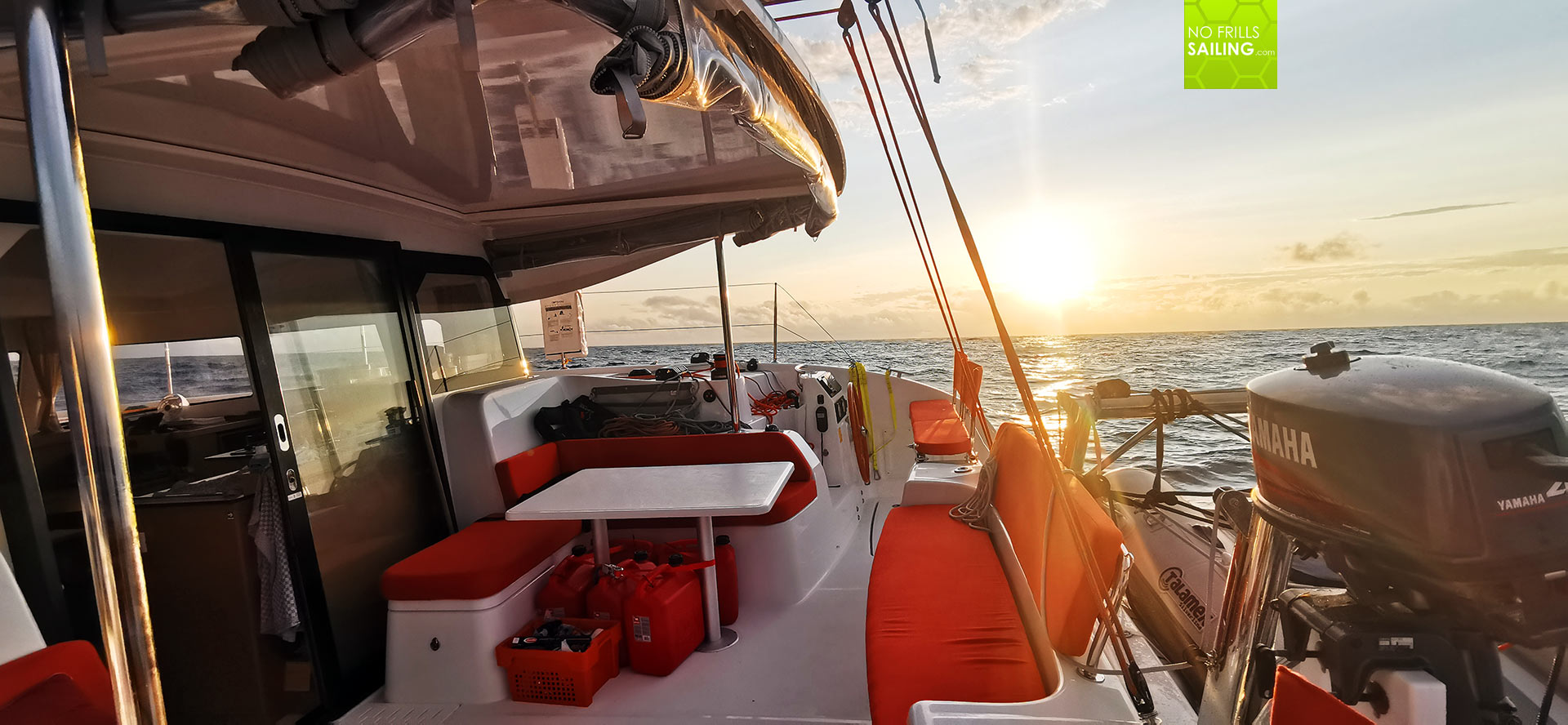
During the following night the storm eased. Being outside I – again – noticed why I love B&G equipment and do not like Raymarine (nor Garmin) very much. See, when night falls you will switch from daylight mode to the redlight night mode. With B&G that is one single click and every instrument connected via NMEA 2000 will follow suit. Not so on our cat: I had to go to every single display and switch individually to night mode. Either I am too stupid or this is a major flaw in the design.
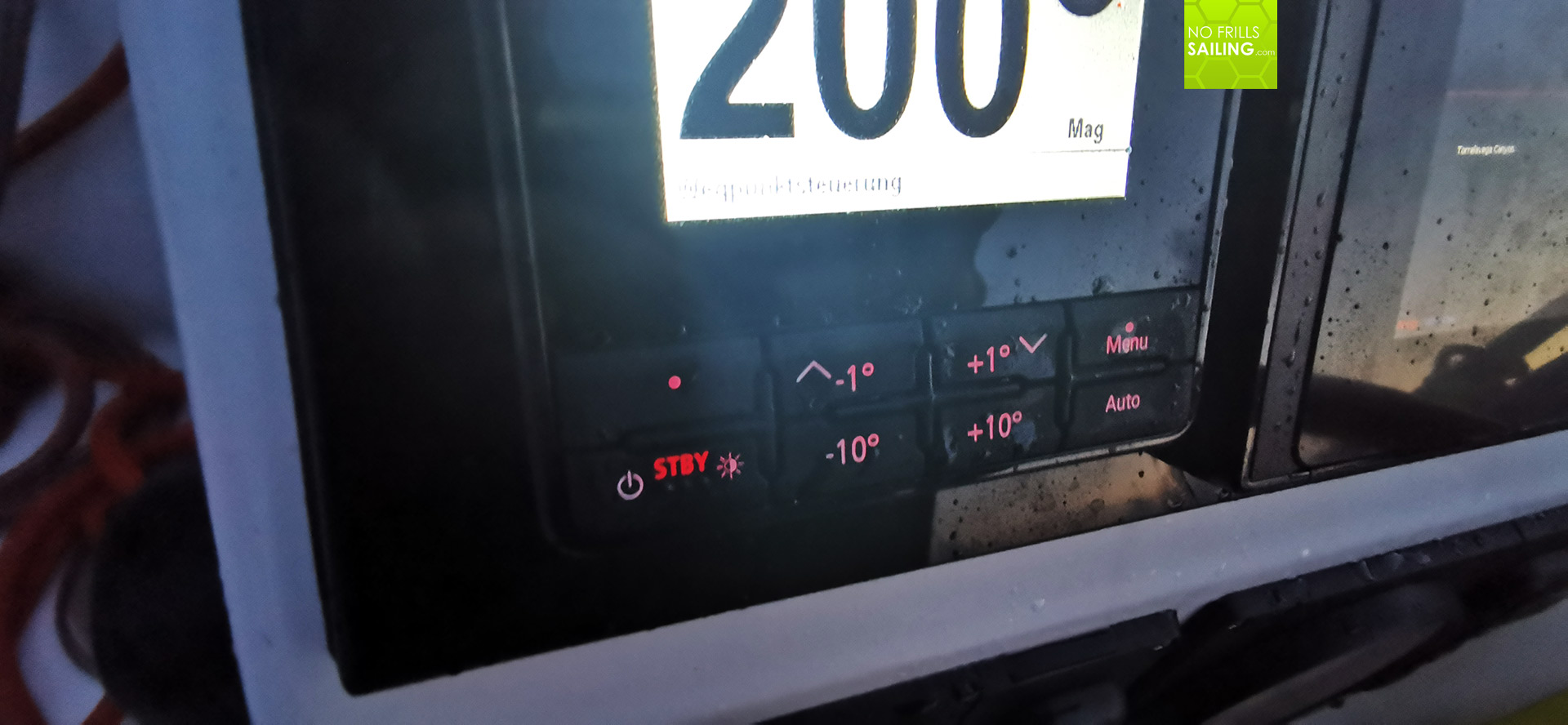
Also, speaking of the panel which controls the auto pilot, the button for light-intensity and disconnection of the autopilot is the same. Who the hell does this? Now, every time I wanted to reduce or increase the brightness of the display, naturally, the autopilot got disconnected. In heavy winds and the sea state we were in that meant instant change of course, fluttering in the sails, loosing of speed. That is absolutely annoying and made me very angry all the time! Again: Who thinks that this was a good idea? There are so many buttons, why the “standby autopilot”-button?
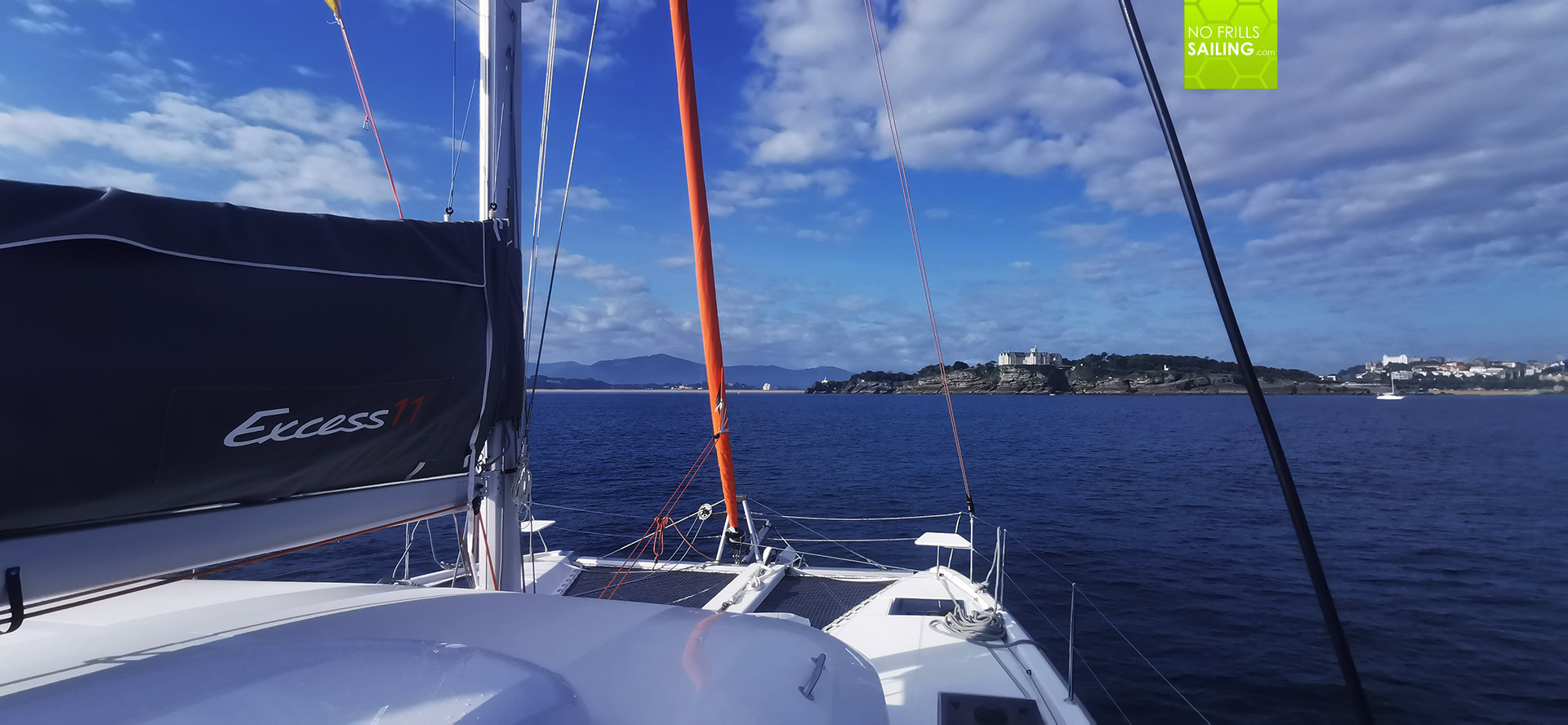
Well, that was the last unnerving detail. Maybe it was me being worn out and tired, but eventually the coastline of Spain got into sight. I un-reefed the mainsail at 0350 a.m. as wind had dropped to 12 knots and the waves calmed down a bit. The catamaran´s speed dropped below 7 knots but hovered around 6.5 to 5.5 knots which was still pretty okay. As the sun went up at last and – even through the thick, rainy clouds, her warm sunshine hit my nose, some of the energy came back to my body and the thrill of reaching land crawled up my throat.
A first verdict: Is the Cat worth the buzz?
At 0450 I took in the jib, some minutes later taking down the mainsail, starting the engines. Wind had eased to a mere 8 knots TWS and shifted to 195 degrees – which was exactly the direction in which Santander was situated. I did not had the will to tack my way in to Santander so we motored some 6 hours in cruising speed against the tide, I shall add, until reaching the estuary. In the meantime my crew mates re-appeared, both still battered and suffering from sea sickness. Talking to them assessing their state of being, I recommended that they should stay here for a full day to recuperate, wait for a calmer sea and resume their voyage. Alone, as I would leave the ship here in Spain.
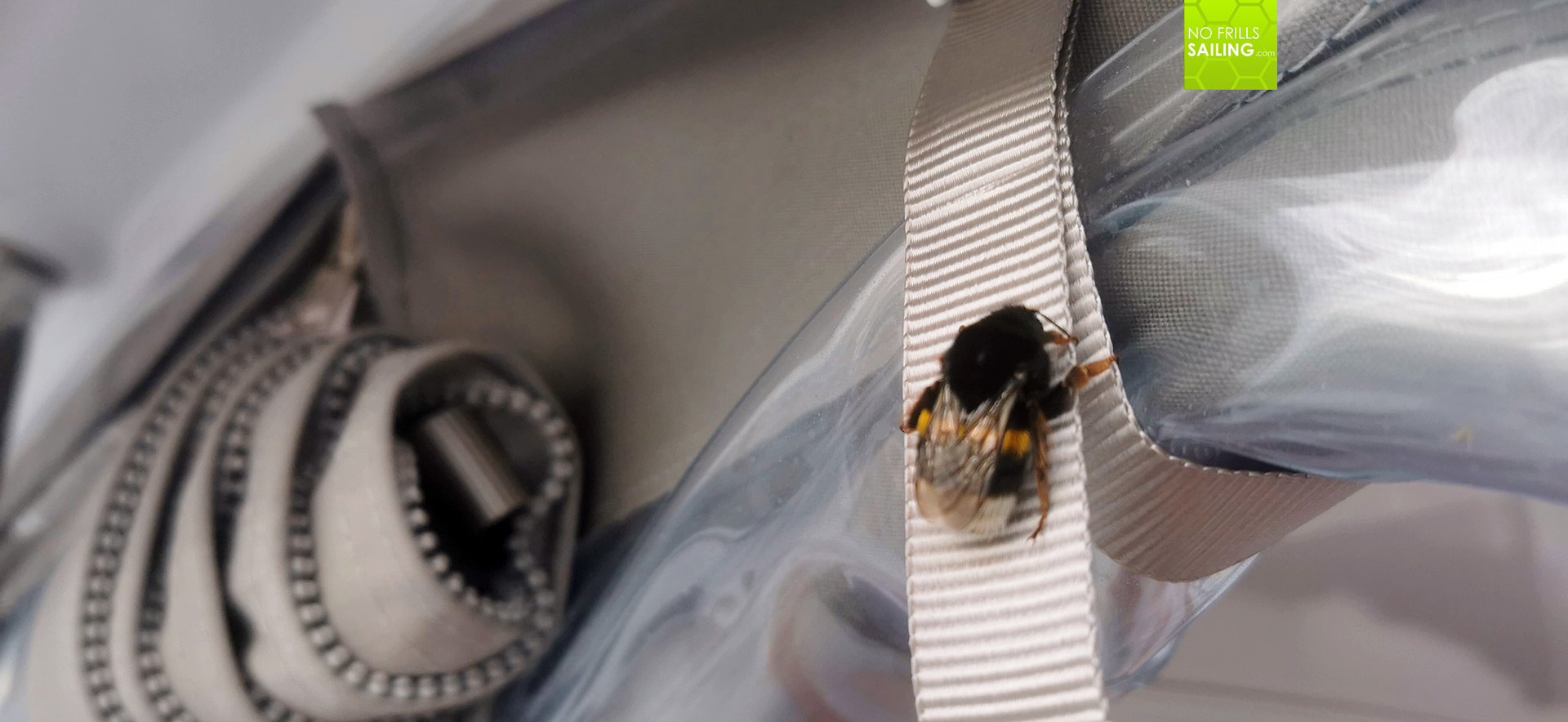
They agreed and even if they did not say it out loud, I think they were relieved of gaining a “day off”. This storm-riding session was seemingly too much for a first time on a cat. Happy indeed was another little mate: Right after we had left Les Sables a thick, beautiful bumblebee had been joining our crew. The little tough insect crawled up one of the cords to secure the side-bimini of the cockpit and had remained there ever since. Even during the storm it hung onto the braid. We brought her to Spain and after we had tied up the boat at pier later, she left, starting a hopefully happy new life there. Now, what is it all about, sailing a catamaran?
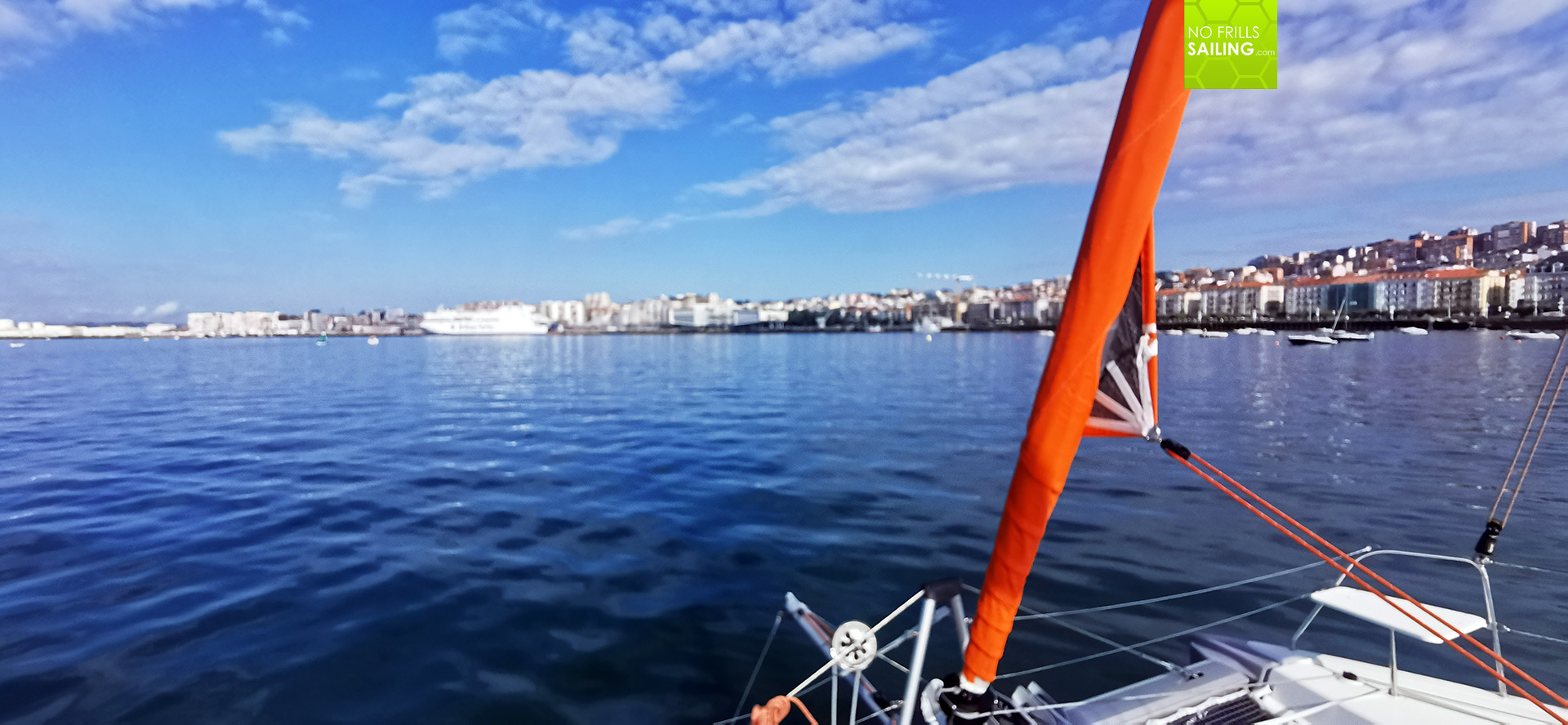
You will read and hear and see mainly two differing strings of opinions. The one will state that a cat is “slow, cannot sail upwind, prone to drift because of big freeboard and generally nothing for real sailors”. The other string will tell you that there is “nothing better for a great sailing vacation than a catamaran.” Well, these opinions might apply to many, but I would say, my opinion is a bit in the middle: Like any other boat out there a catamaran too is just a compromise between many things. I can do some things very, very nicely and will fail to perform in other areas. Like with any other boat too, the question is: What do you want to do with your boat? And as such, for some (say: many) people a cat might be the best solution. For some others it might still be the monohull.

So, enjoying my first beer since 2 days after landing the boat (again perfectly well executed manoeuvre by the older brother, Chapeau!) I thought about it. I am very, very much surprised by the great sailing capabilities of the Excess 11. Honestly, much, much better than expected! It was great fun and easy going to sail, control and trim the boat. The concept of the yard to make a “quick and livelier sister” to the Lagoon catamarans did pay off very well. It´s a fantastic, nimble and sportive boat that is perfect for a sailing family. Going round the world on the Coconut Route in this cat? I absolutely would join in any time – a quick passage maker offering loads of amenities, comfort, style and a lush, safe environment.
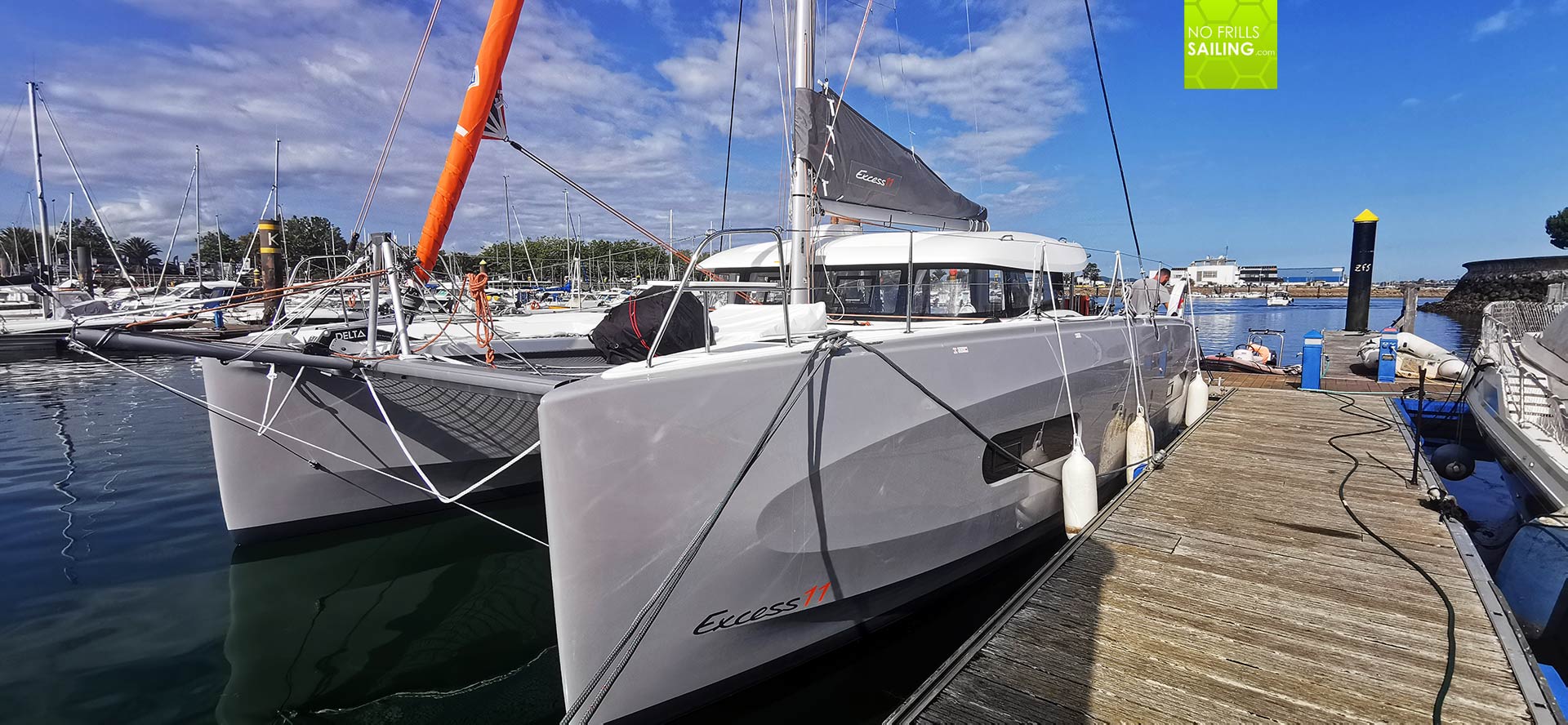
For me, personally, I am still a monohull-guy and I think this won´t change all too quickly. This first, real offshore experience on the catamaran is very, very valuable for me as a sailor as it widens my range of experience. I am proud for the two boys who currently sail the boat as a party of two around Finisterre and further down to enter the Med soon. I wish them the best of luck: Standing proud even when your body is not following, remain on duty and standing your watches is a thing to be proud of. I am back in Les Sables now to take over another Excess 11 catamaran to deliver it to the client: This time the opposite direction, into the English Channel and through the North Sea to Germany. Some 900 miles to which I am looking very much forward too: I hope I can present you afterwards with some more detailed insights and experiences. Stay tuned.
You may read all Excess 11 Catamaran-related articles by clicking the hashtag #excesscatamaran
You may also like to read:
Talking to catamaran-guru Hervé Piveteau
